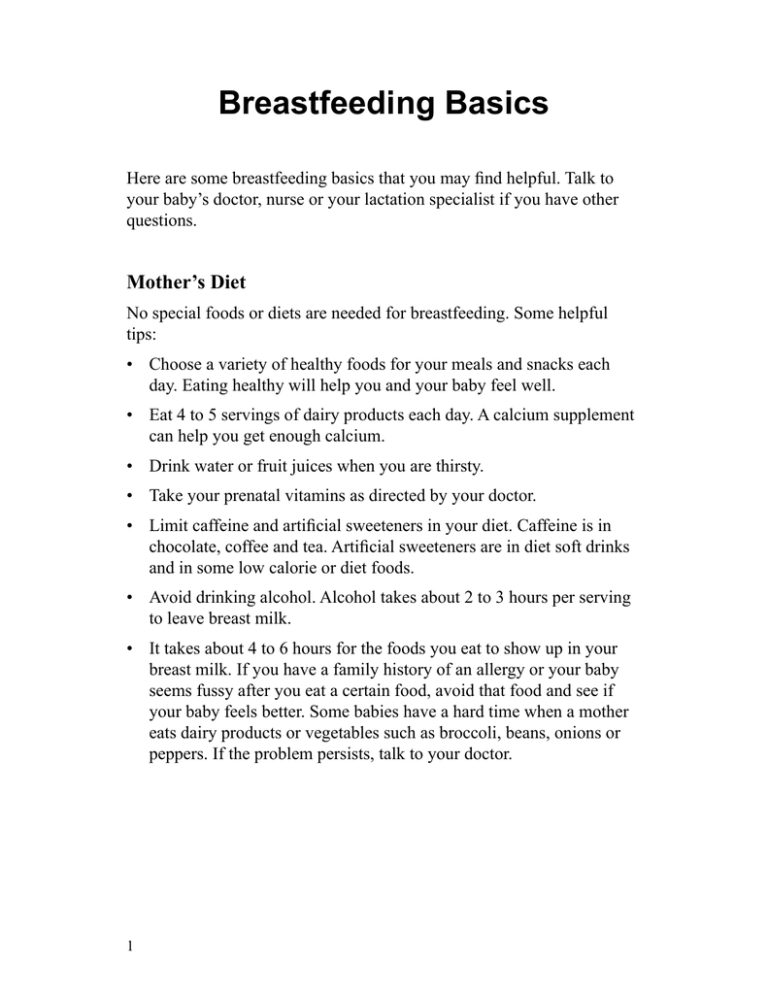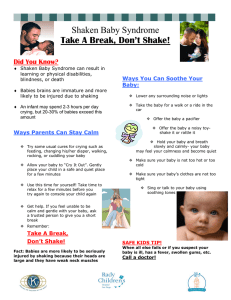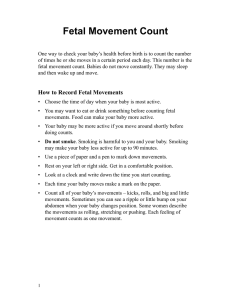Breastfeeding Basics - Spanish - Health Information Translations
Anuncio

Breastfeeding Basics Here are some breastfeeding basics that you may find helpful. Talk to your baby’s doctor, nurse or your lactation specialist if you have other questions. Mother’s Diet No special foods or diets are needed for breastfeeding. Some helpful tips: • Choose a variety of healthy foods for your meals and snacks each day. Eating healthy will help you and your baby feel well. • Eat 4 to 5 servings of dairy products each day. A calcium supplement can help you get enough calcium. • Drink water or fruit juices when you are thirsty. • Take your prenatal vitamins as directed by your doctor. • Limit caffeine and artificial sweeteners in your diet. Caffeine is in chocolate, coffee and tea. Artificial sweeteners are in diet soft drinks and in some low calorie or diet foods. • Avoid drinking alcohol. Alcohol takes about 2 to 3 hours per serving to leave breast milk. • It takes about 4 to 6 hours for the foods you eat to show up in your breast milk. If you have a family history of an allergy or your baby seems fussy after you eat a certain food, avoid that food and see if your baby feels better. Some babies have a hard time when a mother eats dairy products or vegetables such as broccoli, beans, onions or peppers. If the problem persists, talk to your doctor. 1 Información básica sobre lactancia Estos son algunos datos fundamentales que pueden serle útiles. Hable con el médico, enfermera o especialista en lactancia de su bebé si tiene más dudas. Dieta de la madre No se necesitan alimentos o dietas especiales para amamantar. Algunos consejos útiles: • Elija una variedad de alimentos y bocadillos sanos todos los días. Comer sano le ayudará a usted y a su bebé a sentirse bien. • Consuma de 4 a 5 porciones de productos lácteos todos los días. Un suplemento de calcio puede ayudarle a obtener calcio suficiente. • Tome agua o jugos de frutas cuando tenga sed. • Tome sus vitaminas prenatales de acuerdo con las instrucciones de su médico. • Limite la cantidad de cafeína y edulcorantes artificiales en su dieta. La cafeína está presente en el chocolate, café y té. Los edulcorantes artificiales están presentes en los refrescos de dieta y en algunos alimentos bajos en calorías o de dieta. • Evite ingerir bebidas alcohólicas. Cada porción de alcohol tarda alrededor de 2 a 3 horas para eliminarse de la leche materna. • Los alimentos que consume tardan alrededor de 4 a 6 horas en aparecer en la leche materna. Si tiene un historial familiar de alergia o su bebé parece irritado después de que usted consume cierto alimento, evite comerlo y vea si su bebé se siente mejor. Algunos bebés se incomodan cuando su madre consume productos lácteos o ciertas verduras como brócoli, frijoles, cebollas o pimientos. Hable con su médico si el problema persiste. Breastfeeding Basics. Spanish. 1 • Avoid weight loss diets. To lose weight, walk more and limit high calorie foods. Getting Started Colostrum, the first milk your body makes, is very good for your baby. Over the next few days, your breasts will feel fuller, and you will have more milk. Your milk supply will depend on how much milk and how often your baby takes from the breast. The more milk your baby takes, the more milk your breasts will make. The nurses will help you and your baby learn how to breastfeed. Relax and give yourself time to learn. Your baby may be very sleepy the first few days. Your baby’s stomach is small so your baby will need to feed often. You may feel increased thirst while nursing, drowsiness during breastfeeding and mild uterine contractions while breastfeeding the first few days. Avoid feeding your baby from a bottle, either breastmilk or formula, for the first 3 to 4 weeks or until your baby learns to feed well. Sucking from a bottle is a different mouth action. Bottle sucking may interfere with the baby’s nursing at the breast. After the first 3 to 4 weeks, you can try to feed your baby breast milk through a bottle if you would like. If your baby is not able to breastfeed, you can pump your breast milk, feed your baby the breast milk through the bottle or freeze the breast milk in a closed container for later use. Feeding Cues Your baby will give you signs of hunger called feeding cues. Your baby’s feeding cues may include: • Clenched fists • Hands to mouth 2 • Evite las dietas para reducción de peso. Para bajar de peso camine más y limite el consumo de alimentos con un alto contenido de calorías. Para empezar El calostro, la primera leche que produce su cuerpo, es muy buena para su bebé. En los próximos días, sus senos se sentirán más llenos y tendrá más leche. La cantidad de leche que produzca dependerá de la cantidad y la frecuencia con la que su bebé se alimentará del seno. Mientras más leche consuma el bebé, más leche producirán sus senos. Las enfermeras le ayudarán a usted a aprender a amamantar y a su bebé a aprender a mamar. Relájese y dese tiempo para aprender. El bebé puede estar muy soñoliento los primeros días. El estómago del bebé es muy pequeño por lo que necesita alimentarse con frecuencia. Puede que usted se sienta más sedienta durante la lactancia, soñolienta y con contracciones uterinas leves los primeros días que amamante al bebé. Evite alimentar al bebé con biberón, tanto con leche materna como con fórmula, durante las primeras 3 a 4 semanas o hasta que su bebé aprenda a alimentarse bien. La succión del biberón implica una acción diferente de la boca. Succionar del biberón puede interferir con el amamantamiento del bebé. Si desea, después de las primeras 3 a 4 semanas puede intentar darle al bebé leche materna con el biberón. Si su bebé no puede alimentarse del seno, puede sacarse la leche y dársela en biberón o congelar la leche materna en un recipiente cerrado para usarla más tarde. Señales de alimentación A las pistas que le da su bebé cuando quiere alimentarse se les llama señales de alimentación. Entre las señales de alimentación de su bebé pueden incluirse las siguientes: • Puños cerrados • Manos a la boca Breastfeeding Basics. Spanish. 2 • Licking of lips • Moving of arms and legs • Turning the head towards your body • Sounds • Crying Try to begin feeding your baby before he or she becomes too upset. How is my baby doing with breastfeeding? Watch for signs that your baby is latched on to your nipple well and getting milk. Signs may include: • A fast, shallow motion in the cheeks as your baby first latches on that changes to a deep, slow, rhythmic motion. • Motion near your baby’s ear and temple as your baby’s lower jaw moves up and down. • Seeing, hearing, or feeling your baby swallowing. • Feeling a tingling sensation in the breast. Is my baby getting enough milk? If your baby is getting enough milk, your breasts will be full with milk, soft after feedings and refill between feedings. Your baby will: • Have 6 or more wet diapers in a 24 hour period • Sleep between feedings • Have more than 2 bowel movements each day • Gain weight 3 • Chuparse los labios • Mover los brazos y las piernas • Girar la cabeza hacia el cuerpo de la mamá • Sonidos • Llanto Trate de empezar a amamantar a su bebé antes de que se altere demasiado. ¿Cómo le está yendo a mi bebé con el amamantamiento? Busque señales de que el bebé esté bien prendido del pezón y que esté sacando leche. Las señales pueden incluir: • un movimiento rápido y superficial de las mejillas cuando el bebé se acaba de prender del pezón que cambia a un movimiento profundo, lento y rítmico; • movimiento cerca del oído y sien conforme la mandíbula del bebé sube y baja; • ver, oír o sentir cuando el bebé traga; • sentir un hormigueo en el seno. ¿Toma mi bebé suficiente leche? Si el bebé está tomando suficiente leche, sus senos estarán llenos de leche, blandos después de amamantarlo y rellenos entre comida y comida. Su bebé: • mojará 6 o más pañales en un período de 24 horas; • dormirá entre las alimentaciones; • defecará más de 2 veces al día; • aumentará de peso. Breastfeeding Basics. Spanish. 3 A healthy, full term baby who is nursing well does not need extra water or formula. Do not feed your baby extra water or formula unless ordered to do so by your baby’s doctor. Talk to your baby’s doctor, nurse or your lactation specialist if you do not think that your baby is getting enough milk. How often will my baby feed? Feedings are timed from the start of one feeding to the start of the next. At first, try to feed your baby every 2 to 3 hours during the day and evening, and at least every 4 hours during the night. If your baby gives feeding cues, feed your baby. Your baby may want several feedings very close together. By the end of the first week, your baby will be nursing 8 to 12 times in 24 hours. As your baby and your milk supply grow, your baby may begin feeding less often. Even after babies are able to sleep for longer periods, their sleep is sometimes disturbed by dreams, hunger or a busy day. Expect that your baby will wake at night and may need to be fed. Babies have growth spurts in their first 6 months and will nurse more often during them. By feeding more often, your body will make more milk to get through the growth spurts. These spurts often last 3 to 5 days. How long will my baby feed? Feed your baby until he shows signs that he is full such as slowing down sucking and then detaching himself from the breast, and relaxing his hands, arms and legs. If you stop before your baby is done, your baby may not get the high fat milk. This is the milk that is best for growth. 4 Un bebé sano y nacido a término que está alimentándose bien del pecho no necesita más agua o fórmula. No le dé agua adicional o leche de fórmula a su bebé a menos que así lo indique su médico. Hable con el médico, enfermera o especialista en lactancia de su bebé si cree que su bebé no está obteniendo leche suficiente. ¿Con qué frecuencia se alimentará mi bebé? El tiempo de cada alimentación se mide desde que inicia una hasta el inicio de la siguiente. Primero trate de alimentar a su bebé cada 2 a 3 horas durante el día y la tarde y como mínimo, cada 4 horas durante la noche. Si su bebé muestra señales de querer comer, aliméntelo. Puede que su bebé desee varias alimentaciones en un lapso muy corto de tiempo. Al finalizar la primera semana, su bebé estará mamando de 8 a 12 veces en un periodo de 24 horas. Es posible que empiece a alimentarse con menos frecuencia conforme su suministro de leche y su bebé crezcan. Aun después de que los bebés pueden dormir durante periodos más prolongados, a veces su sueño se interrumpe por sueños, hambre o un día ocupado. Es normal que su bebé se despierte de noche y necesite alimentarse. Los bebés tienen periodos de crecimiento acelerado en sus primeros 6 meses y se alimentarán con más frecuencia durante este periodo. Al alimentarse con mayor frecuencia, su cuerpo producirá más leche para poder alimentarlo durante estos periodos. Estos periodos a menudo duran de 3 a 5 días. ¿Con qué frecuencia se alimentará mi bebé? Alimente a su bebé hasta que muestre señales de estar satisfecho, como disminuir la velocidad con la que succiona, desprenderse luego del seno y relajar las manos, brazos y piernas. Si se detiene antes de que su bebé haya terminado, es posible que no obtenga la leche con alto contenido de grasa. Esta es la mejor leche para el crecimiento. Breastfeeding Basics. Spanish. 4 Allow your baby to completely finish feeding on the first breast. This may take 10 to 25 minutes. Then offer the second breast. Your baby may feed for a while on that breast, or not want the second breast at all. Alternate the breast you begin with at each feeding. Some mothers track which breast to begin with by pinning a safety pin to their bra strap. Waking the Sleeping Baby If your baby is in a deep sleep, do not wake your baby for a feeding. If your baby is asleep but has some body motions such as eye motion under the lid, active mouth and tongue motion, or sucking in sleep, this is the best time to wake your baby for a feeding. At night, dim the lights and keep the room quiet. Avoid startling movements. Wake the baby gently by moving your baby or you can change your baby’s diaper. If after 15 minutes your baby shows poor interest in breastfeeding, try an hour later. Talk to a doctor, nurse or lactation specialist if you have any questions or concerns. 2007 – 11/2011 Health Information Translations Unless otherwise stated, user may print or download information from www.healthinfotranslations.org for personal, non-commercial use only. The medical information found on this website should not be used in place of a consultation with your doctor or other health care provider. You should always seek the advice of your doctor or other qualified health care provider before you start or stop any treatment or with any questions you may have about a medical condition. The Ohio State University Medical Center, Mount Carmel Health System, OhioHealth and Nationwide Children’s Hospital are not responsible for injuries or damages you may incur as a result of your stopping medical treatment or your failure to obtain medical treatment. 5 Permita que su bebé termine de alimentarse completamente en el primer seno. Esto puede llevarle de 10 a 25 minutos. Después ofrézcale el otro seno. Es posible que su bebé se alimente por un rato de ese seno o que no quiera el segundo seno en absoluto. Alterne el seno con el que empieza a amamantarlo en cada alimentación. Algunas madres se ponen un segurito en el tirante del sostén para recordar con qué seno iniciar la siguiente sesión de amamantamiento. Cómo despertar al bebé dormido Si su bebé está durmiendo profundamente, no lo despierte para amamantarlo. Si su bebé está dormido pero algunas partes de su cuerpo presentan movimiento, tal como movimiento ocular debajo del parpado, boca activa y movimiento de la lengua, succionar dormido, es el mejor momento para despertarlo y amamantarlo. En la noche, atenúe las luces y mantenga la habitación en silencio. Evite movimientos bruscos o sorpresivos. Despierte al bebe moviéndolo con gentileza o cambiándole el pañal. Si después de 15 minutos su bebé no muestra mucho interés en mamar, inténtelo una hora después. Hable con su médico, enfermera o especialista en lactancia si tiene alguna pregunta o duda. 2007 – 11/2011 Health Information Translations Unless otherwise stated, user may print or download information from www.healthinfotranslations.org for personal, non-commercial use only. The medical information found on this website should not be used in place of a consultation with your doctor or other health care provider. You should always seek the advice of your doctor or other qualified health care provider before you start or stop any treatment or with any questions you may have about a medical condition. The Ohio State University Medical Center, Mount Carmel Health System, OhioHealth and Nationwide Children’s Hospital are not responsible for injuries or damages you may incur as a result of your stopping medical treatment or your failure to obtain medical treatment. Breastfeeding Basics. Spanish. 5


